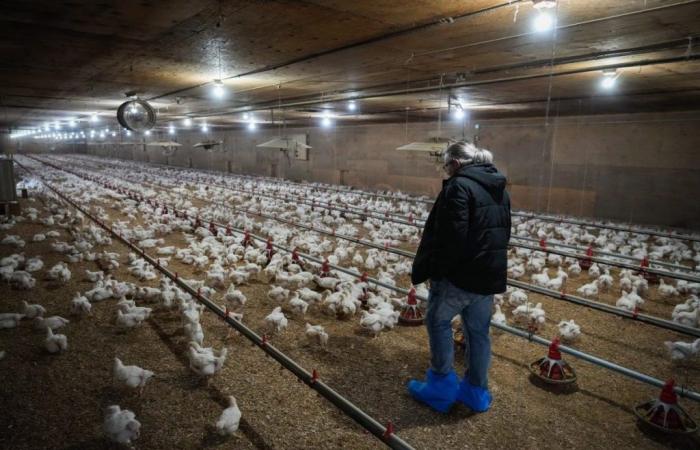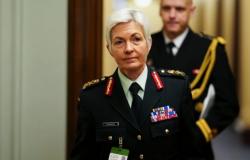MONTREAL — Cases of highly pathogenic avian influenza were detected for the first time in 2022 in Quebec. Since then, more than a million birds have been infected, leaving affected producers traumatized and keeping those spared on alert.
Since the start of the year, three farms have declared the presence of highly pathogenic avian influenza type H5N1; the most recent case was on April 10, the health ministry said. This bodes well for now, compared to the 28 sites affected in 2023 and the 23 sites in 2022.
According to the most recent data from the Canadian Food Inspection Agency (CFIA), 1.4 million birds have been infected in Quebec, making it the third most affected province behind Alberta (1.8 million) and British Columbia (6 million).
However, the summer season is only just beginning and producers are more fearful of the fall when migratory birds — which spread the disease — are numerous to fly over the fields.
“We can’t help but think about it, especially during periods of migration. (…) When we walk on the farm and we hear a sailboat of geese passing over the farm, we can no longer say that we find it pretty, it worries us more because we hear the noise and lots of images come to mind and the dangers of contamination,” declared Benoît Fontaine, general director of the Quebec Poultry Disease Control Team at the Union of Agricultural Producers (UPA).
Services to keep away birds that land on an agricultural site are also offered by the UPA.
Pier-Luc Leblanc, a turkey and poultry farmer from Montérégie, experienced an ordeal in December 2023 when the virus entered one of his buildings, despite all the biosecurity standards in place.
Mr. Leblanc is pleased with the case count for 2024, but he is not letting his guard down. “For the fall, we are not out of the woods, it will come. In my case, there were a lot of migratory birds the week before I was infected,” he says.
In Quebec, when a case is detected, all birds on the farm must be euthanized and buildings must be disinfected from top to bottom.
“The fear is not experiencing the financial loss, it is reliving all the steps to restart the site. The financial loss is boring, we don’t want to lose money in life, but to rethink euthanizing the birds and composting above all. Washing is not that bad, (…) but euthanasia and compost, I’m scared to death, I don’t want to go through that again,” testified Mr. Leblanc.
Jean-Pierre Vaillancourt, full professor at the Faculty of Veterinary Medicine at the University of Montreal, emphasizes that breeders have an emotional attachment to their animals on several levels. “These are people who are proud of what they do, they provide a quality source of protein that doesn’t cost too much,” he explains.
Mr. Fontaine confirms that it is “a very serious trauma” for certain breeders. “We are there at the heart of farm families and psychological support at the Union des consommateurs du Québec to support people who are going through this ordeal,” he said.
Food waste is also a consequence. “We raise these animals to ultimately consume them, but not to destroy them along the way while they are still adolescents. It’s food waste, it’s a financial loss and the Canadian food inspection agency – which does an excellent job – still takes control of your farm, nothing more and nothing less. So you are at home without being there. It’s traumatic,” adds Mr. Fontaine.
Compost from carcasses
In 2023, Mr. Leblanc had three buildings with a total of 32,000 turkeys and four buildings with 90,000 chickens. They all had to be shot.
He will remember the vet’s call telling him the bad news all his life. “Your legs fall off when you leave,” he remembers.
From that moment, he felt enormous pressure. “Life stops turning. Everything you have around this site no longer matters, family, there is nothing that matters anymore. You react to protect. And at the same time, you are not without thinking about the financial risk. You think about your birds that you won’t sell,” he admits.
Mr. Leblanc immediately wanted to ensure that his staff was safe due to the risk of contamination in humans, although it was minimal.
For Mr. Leblanc’s farm, the euthanasia procedure was completed in five days. The carcasses cannot be moved elsewhere to avoid spreading the disease. Dead birds must be composted on site, a particularly difficult step for the producer and his employees.
“It’s work that is inhumane, what we are asked to do, in terms of mental health. You have to coordinate the euthanasia with the team that comes to do it. Post-euthanasia, you and your staff have to compost your birds on your own site,” describes Mr. Leblanc.
“You load up dead birds, you have a white carpet of dead birds on the site. Just to see the image… it’s unbelievable what the producer has to go through, but my colleagues have gone through it too,” he continues.
Mr. Leblanc’s only wish was to “return to normal life.”
Five weeks later, after the decontamination stage of the buildings, new birds were able to settle in. During the first months, Mr. Leblanc was afraid to enter his buildings for fear of recontaminating his birds. “We know that the big risk is us who do it. (…) It really has to be a sterile area. I was super scared. You know you had a nightmare yesterday, but you know you’re going to have others.”
Financial losses
Avian flu also has a financial impact on the community. “It can have quite significant impacts on ordinary people. Financially, just looking at the Americans, the price of eggs has increased enormously recently,” says Mr. Vaillancourt.
In Canada, the government compensates the producer for the market value of the birds that are destroyed and the entire process of depopulation and disposal of infected carcasses, but not the disinfection.
The CFIA supervises the cleaning work, but it is the producer’s responsibility to sanitize the premises.
Mr. Leblanc had a value of $1 million for his poultry and despite financial compensation of this value, he estimates having lost $350,000.
Martin Pelletier, agronomist and coordinator of the Quebec Poultry Disease Control Team (EQCMA), indicated that there is an insurance program developed in partnership with the industry which covers a large part of the cleaning and disinfection costs. .
“There are always losses that the producer will assume because if his herd is depopulated, and sometimes this interrupts his production cycle, he cannot necessarily resume his production over time,” explains Mr. Pelletier.
According to him, if we take into account personnel costs, the Government of Canada would have spent nearly $300 million in costs related to avian flu since the end of 2021.
Mr. Leblanc hopes that if a cure or vaccine is found, export rules would be relaxed, because currently several countries do not accept meat from vaccinated animals. “But we have to solve the problem, we cannot live year after year with this pressure as breeders and as a society,” he argues.
—
The Canadian Press’ health content receives funding through a partnership with the Canadian Medical Association. The Canadian Press is solely responsible for editorial choices.






